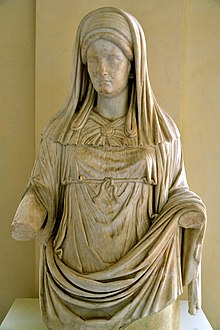
Back Vestaalse maagd Afrikaans عذارى فستال Arabic عذارى فيستا ARZ Vestal bakirəsi Azerbaijani Вясталкі Byelorussian Весталка Bulgarian Vestalenn Breton Vestal Catalan Vestálky Czech Веста хĕрĕсем CV


In ancient Rome, the Vestal Virgins or Vestals (Latin: Vestālēs, singular Vestālis [wɛsˈtaːlɪs]) were priestesses of Vesta, virgin goddess of Rome's sacred hearth and its flame.
The Vestals were unlike any other public priesthood. They were chosen before puberty from several suitable candidates, freed from any legal ties and obligations to their birth family, and enrolled in Vesta's priestly college of six priestesses. They were supervised by a senior vestal but chosen and governed by Rome's leading male priest, the pontifex maximus; in the Imperial era, this meant the emperor.
Vesta's acolytes vowed to serve her for at least thirty years, study and practise her rites in service of the Roman State, and maintain their chastity throughout. In addition to their obligations on behalf of Rome, Vestals had extraordinary rights and privileges, some of which were granted to no others, male or female.
The Vestals took turns to supervise Vesta's sacred hearth so that at least one Vestal was stationed there at all times. Vestals who allowed the sacred fire to go out were punished with whipping. Vestals who lost their chastity were guilty of incestum, and were sentenced to living burial, a bloodless death that must seem voluntary. Their sexual partners, if known, were publicly beaten to death. These were infrequent events; most vestals retired with a generous pension and universal respect. They were then free to marry, though few of them did. Some appear to have renewed their vows.
In 382 AD, the Christian emperor Gratian confiscated the public revenues assigned to the cult of Vesta in Rome. Soon after, the Vestals vanished from the historical record.